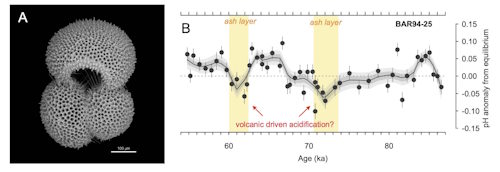
FORVOL
Exploring sulfur, metals, and REE in foraminifera as a new paleoarchive of volcanic processes on ocean and climate
Scientific responsibility :
- William Gray
- Eric Douville
- Franck Bassinot
- Annachiara Bartolini
Methodological axes :
Thematic fields :
Disciplinary sectors :
Funding :
- DIM PAMIR
Project ID : IDF-DIM-PAMIR-2024-4-007
Summary :
The elemental and isotopic signals recorded in the shells of planktic foraminifera (single celled calcifying protists) are widely applied as proxies for a host of paleoenvironmental parameters. When ash falls come into contact with the surface ocean they release sulfur, metal cations (eg. Zn2+, Mn2+, Fe2+) and rare earth elements (REE) into the seawater. These elements can be incorporated into the shells of planktic foraminifera, such that their shells are potential archives of past volcanism. However, due to the presence of polyatomic inteferences, it is not possible to measure sulfur, and the suite of other elements (iron, zinc, rare earth elements [REE]) associated with volcanism, in foraminifera using classical quadrupole ICP-MS methods. We will capitalise on recent analytical developments using triple quadrupole ICP-MS technology, which circumvents these interferences, and develop a new method to simultaneously analyse these trace elements in small foraminiferal samples (~100 ug CaCO3) for the first time. We propose to apply this new toolbox in a first case study tracing the impact of the explosive Toba super eruption on surface ocean chemistry and planktic foraminiferal biocalcification across the interglacial-glacial transition MIS5-MIS4. To this end, we will target a sediment core containing well-characterised tephra layers from the Toba eruptions to generate a record of S/Ca, Fe/Ca, Zn/Ca and REE anomalies in planktic foraminifers spanning the multiple eruptions. In conjunction, we plan to obtain new sulfur isotope (d34S) and calcification intensity data from the same planktic foraminiferal samples. We will compare these new results with existing foraminiferal boron isotope data from the same core (a proxy for sea surface pH). Taken together, this multi-proxy approach will allow us to fingerprint volcanic inputs to the ocean during the Toba eruptions, allowing us to trace the acidifying and/or toxic effects of volcanism on the biocalcification of planktic foraminifera and to gain new insights into the impact of volcanic emissions on ocean biogeochemistry.
Post-doctoral student: Ana Alves
Legend and credit
(A) SEM image of a very well preserved planktic foraminifer Globigerinoides ruber from a layer containing Toba tephra in marine core BAR94-25 (Andaman Sea), S. Pont (MNHN IMPMC) (B) boron isotope derived surface pH anomaly (calculated as disequilibrium from contemporaneous atmosphere) in core BAR94-25 showing two acidification events associated with the Toba ash layers (Alves et al. 2024). One of the major aims of this project is to trace and quantify volcanic sulphur input to the surface ocean during these acidification events.
(A) SEM image of a very well preserved planktic foraminifer Globigerinoides ruber from a layer containing Toba tephra in marine core BAR94-25 (Andaman Sea), S. Pont (MNHN IMPMC) (B) boron isotope derived surface pH anomaly (calculated as disequilibrium from contemporaneous atmosphere) in core BAR94-25 showing two acidification events associated with the Toba ash layers (Alves et al. 2024). One of the major aims of this project is to trace and quantify volcanic sulphur input to the surface ocean during these acidification events.

